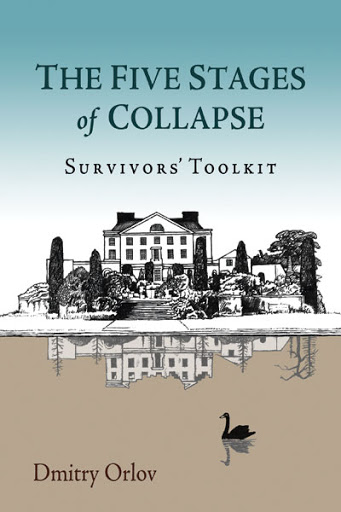
This book is based on the identically titled article I published on this blog in February of 2008, just as financial collapse was starting to gather steam. Since then, this article has been read nearly 100,000 times on this blog alone (it has been reposted on many other web sites) and it is its enduring popularity that has convinced me to write a book-length treatment.
In this article, I proposed a taxonomy of collapse, splitting it out into five stages—financial, commercial, political, social and cultural—and tied each of the five collapse stages to the breaching of a specific level of trust, or faith, in the status quo. Although each stage causes physical, observable changes in the environment, these can be gradual, while the mental flip is generally quite swift, because it is something of a cultural universal that nobody (but a real fool) wants to be the last fool to believe in a lie.
Stage 1: Financial collapse. Faith in “business as usual” is lost.
Stage 2: Commercial collapse. Faith that “the market shall provide” is lost.
Stage 3: Political collapse. Faith that “the government will take care of you” is lost.
Stage 4: Social collapse. Faith that “your people will take care of you” is lost.
Stage 5: Cultural collapse. Faith in “the goodness of humanity” is lost.
A casual perusal of history books will show that these various stages of collapse occur with great regularity. Unlike other animals, humans have a marked tendency to form complex social hierarchies which never endure because collapse is programmed into the very nature of complex social hierarchies. In fact, the first three stages can often be viewed as healthy developments.
For instance, a prompt collapse of the current financial/commercial/political scheme, which is wedded to the fatally flawed concept of infinite economic growth on a finite planet, would be most welcome, for it would give humanity a new lease on life—by leaving to the future generations a planet that is less than 100% despoiled and poisoned by industry. There are countless books that describe the predicament of industrial civilization in accurate and compelling detail, but they ruin the effect by containing certain telltale turns of phrase: “Unless we...” and “We must...” This book is not one of them. Here, the reader is being asked to take it as read that collapse will occur, and, instead of wasting time on what “we” must “do” about it, describes what each stage of collapse entails and what adaptations and coping mechanisms have proven effective in attempting to survive its consequences.
The description of each stage of collapse is accompanied by a case study that details what a successful adaptation to that stage of collapse looks like:
- In the case of financial collapse, the example is Iceland—the only country so far that had successfully fought off international efforts to saddle its people with the debts incurred by its defunct private banks, allowing it to recover economically even as the US and the EU, which bailed out their failed banks, continue to sink deeper and deeper.
- Commercial collapse is shown as seen through the eyes of the Russian mafia and criminal syndicates, explaining how “the free market,” in order to be able to operate, requires, at the very least, a protection racket, be it the mafia or the government. For those brought up on the pablum of nonviolence, this case study offers a useful lesson on the constructive uses of violence
- Political collapse as a steady state condition is described through the example of the Pashtuns—one of the world's largest ethnic groups inhabiting parts of Afghanistan and Pakistan—whose code of honor (Pashtunwali, or the Pashtun Way) has allowed them to fight off (and, in some cases, help destroy) every empire that ever blundered into their habitat. (They are known to the consumers of Western propaganda primarily as the Taleban.) The Pashtuns allow us to clearly see the dividing line between a hierarchical, imperialist, collapse-bound society and that of a steady-state, entrenched, well-organized anarchy.
- Social collapse—or, rather, a very stable lack thereof—is studied with reference to the Roma, or Gypsies, who have survived intact over many centuries and who now number in the millions both in Europe and the US in spite of being shut out financially, commercially and politically in every country they inhabit. This case study allows us to ponder what it means to be marginalized, for to be marginalized by a collapse-bound society can be a blessing in disguise.
- Cultural collapse is explored with the help of the Ik, an African tribe of hunter-gatherers who, once they were prevented from hunting and gathering, survived by mutating into a cultural form that we may not wish to recognize as human—yet they persist. The Ik allow us to explore an important question: Is survival at all cost really worth it?
